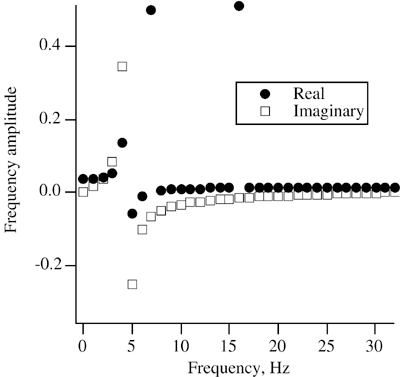Spectral Leakage
| The DFT creates a frequency spectrum by mapping the signal amplitude at various discrete time samples into frequency amplitudes at various discrete frequencies. Each discrete frequency location ( f k ) in the frequency response is called a bin . The frequency of a particular bin depends on its location in the frequency response (its k value), the sample rate, and the total sample time. If there is a bin corresponding to the frequency of each component of the signal, the result is a nice, sharp computed frequency spectrum. But what happens if a signal frequency lies between two bins? For example, let's say a signal has a component at 8.33 Hz and the DFT uses frequency bins 1 Hz apart. Since there isn't a bin that exactly corresponds to the signal frequency, the DFT will distribute the frequency amplitude among the 8 and 9 Hz bins and surrounding bins. This effect is called spectral leakage . The frequency response no longer shows sharp peaks but the frequency amplitude is spread out along the spectrum. To demonstrate what spectral leakage looks like, let's modify the previous composite cosine function to include a component at 4.4 Hz. The steps are shown in Eq. (22.23). Equation 22.23 When we sample the signal at the same 64 samples a second for 1 second and send the data to the discreteFT() method, Figure 22.6 shows the resulting frequency response. (The negative frequency spectrum has again been omitted.) Figure 22.6. Effect of spectrum leakage The 2 Hz frequency amplitude peak in Figure 22.6 is now lower and the amplitude of neighboring bins has increased both positively and negatively. The other interesting thing about this figure is that an imaginary component has been introduced to the frequency response. Because there were bins at 7 Hz and 16 Hz, the peaks at those frequencies are not subject to spectrum leakage and still show sharp peaks. What is the answer to spectral leakage? One solution is to modify the sample number and/or sample time such that there is a bin at the frequency of every component in the signal. In the previous example, if we had taken 32 samples per second over a 10 second sample time (320 total samples) there would have been a bin at 4.4 Hz and the frequency response would have come out cleanly. |
EAN: 2147483647
Pages: 281
